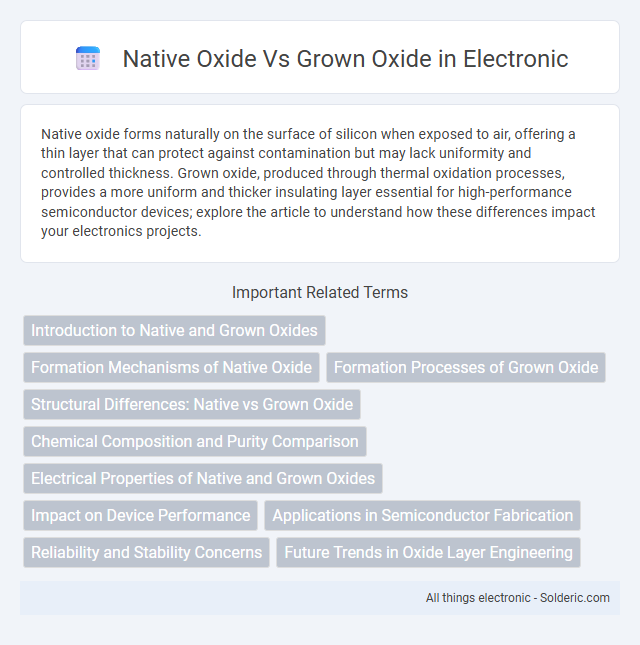Native oxide forms naturally on the surface of silicon when exposed to air, offering a thin layer that can protect against contamination but may lack uniformity and controlled thickness. Grown oxide, produced through thermal oxidation processes, provides a more uniform and thicker insulating layer essential for high-performance semiconductor devices; explore the article to understand how these differences impact your electronics projects.
Comparison Table
| Feature | Native Oxide | Grown Oxide |
|---|---|---|
| Formation Method | Spontaneous oxidation in air | Thermal oxidation or chemical growth |
| Thickness | Very thin (1-3 nm) | Controlled and thicker (up to several hundred nm) |
| Uniformity | Non-uniform, irregular | Highly uniform and controlled |
| Quality | Low quality, porous | High quality, dense and stable |
| Electrical Properties | Poor insulating properties | Excellent dielectric strength |
| Applications | Surface protection, minimal barrier | Semiconductor devices, gate oxide layers |
| Control Over Growth | Limited, natural process | Precise control via temperature, time, atmosphere |
Introduction to Native and Grown Oxides
Native oxide forms naturally on the surface of silicon when exposed to air, creating a thin insulating layer typically measuring 1 to 2 nanometers. Grown oxide, produced through controlled thermal oxidation processes, results in thicker and high-quality silicon dioxide layers ranging from a few nanometers up to several micrometers, essential for semiconductor device fabrication. The characteristics and thickness of native and grown oxides significantly influence electronic properties, such as interface trap density and dielectric strength, impacting device performance and reliability.
Formation Mechanisms of Native Oxide
Native oxide forms spontaneously on semiconductor surfaces such as silicon when exposed to ambient air, driven primarily by natural oxidation processes involving oxygen and moisture. This ultrathin oxide layer, typically 1-3 nm thick, results from the chemisorption of oxygen molecules and subsequent diffusion through the oxide film. The formation mechanism contrasts with thermally grown oxide, which is produced by controlled oxidation at elevated temperatures, allowing precise thickness and quality adjustments.
Formation Processes of Grown Oxide
Grown oxide forms through controlled thermal oxidation, where silicon wafers react with oxygen or water vapor at high temperatures, creating a uniform, high-quality oxide layer. This process allows precise control over oxide thickness and density compared to native oxide, which forms spontaneously at room temperature. Your semiconductor devices benefit from grown oxide's superior electrical properties and reliability in microelectronics fabrication.
Structural Differences: Native vs Grown Oxide
Native oxide forms naturally on silicon surfaces as a thin, irregular layer typically 1 to 3 nm thick, characterized by a non-uniform, amorphous structure with defects and varying stoichiometry. Grown oxide, produced through controlled thermal oxidation processes, results in a thicker, uniform, and dense SiO2 layer exhibiting superior electrical properties and consistent stoichiometry. Understanding these structural differences helps optimize Your semiconductor device performance by selecting the appropriate oxide type for specific applications.
Chemical Composition and Purity Comparison
Native oxide forms naturally on semiconductor surfaces, primarily consisting of silicon dioxide (SiO2) mixed with contaminants like carbon and moisture, resulting in lower purity and variable chemical composition. Grown oxide, produced through controlled thermal oxidation processes, offers high-purity SiO2 with a uniform and well-defined chemical structure free from extraneous impurities. Your device's performance greatly benefits from the superior chemical composition and purity of grown oxide, ensuring enhanced reliability and electrical properties.
Electrical Properties of Native and Grown Oxides
Native oxides typically exhibit lower dielectric strength and higher leakage currents compared to grown oxides due to their irregular structure and impurity incorporation. Grown oxides, formed through controlled thermal oxidation, possess superior electrical properties including higher breakdown voltages and better interface quality, which significantly enhance device performance. Understanding these differences helps you select the appropriate oxide layer for reliable semiconductor insulation and optimal electrical characteristics.
Impact on Device Performance
Native oxide, typically thin and irregular, often exhibits higher defect densities and interface states, negatively affecting carrier mobility and increasing leakage currents in semiconductor devices. Grown oxide, formed under controlled conditions such as thermal oxidation, provides a uniform, high-quality dielectric layer with superior electrical properties, enhancing device reliability and threshold voltage stability. The improved interface quality of grown oxide significantly reduces trap states, resulting in better channel conductivity and overall enhanced device performance.
Applications in Semiconductor Fabrication
Native oxide forms naturally on silicon surfaces and is primarily used for surface passivation and protection in semiconductor fabrication, offering minimal control over thickness and uniformity. Grown oxide, produced through thermal oxidation processes, provides precise control over layer thickness and quality, making it essential for gate dielectrics, insulation layers, and high-performance device interfaces in integrated circuits. The superior electrical properties and uniformity of grown oxide layers enable advanced applications such as MOSFETs and dielectric isolation in microelectronics manufacturing.
Reliability and Stability Concerns
Native oxide layers, typically formed naturally on semiconductor surfaces, often exhibit inconsistent thickness and composition, leading to potential reliability and stability issues in electronic devices. In contrast, grown oxide layers, produced through controlled thermal oxidation processes, provide uniform thickness and higher quality interfaces, enhancing device durability and electrical performance. The superior structural integrity of grown oxides significantly reduces defect densities, improving long-term stability and reliability in semiconductor applications.
Future Trends in Oxide Layer Engineering
Future trends in oxide layer engineering emphasize advanced control over native oxide and grown oxide properties to enhance semiconductor device performance and reliability. Innovations in atomic layer deposition and molecular beam epitaxy enable precise thickness and composition tuning, crucial for next-generation transistor scaling and quantum computing applications. Your ability to tailor oxide interfaces will drive breakthroughs in energy-efficient electronics and flexible device architectures.
Native Oxide vs Grown Oxide Infographic

 solderic.com
solderic.com